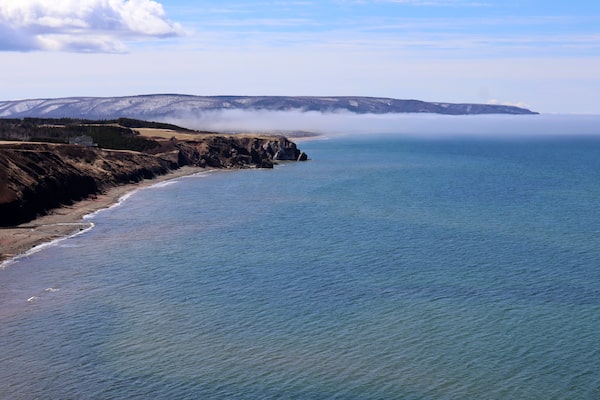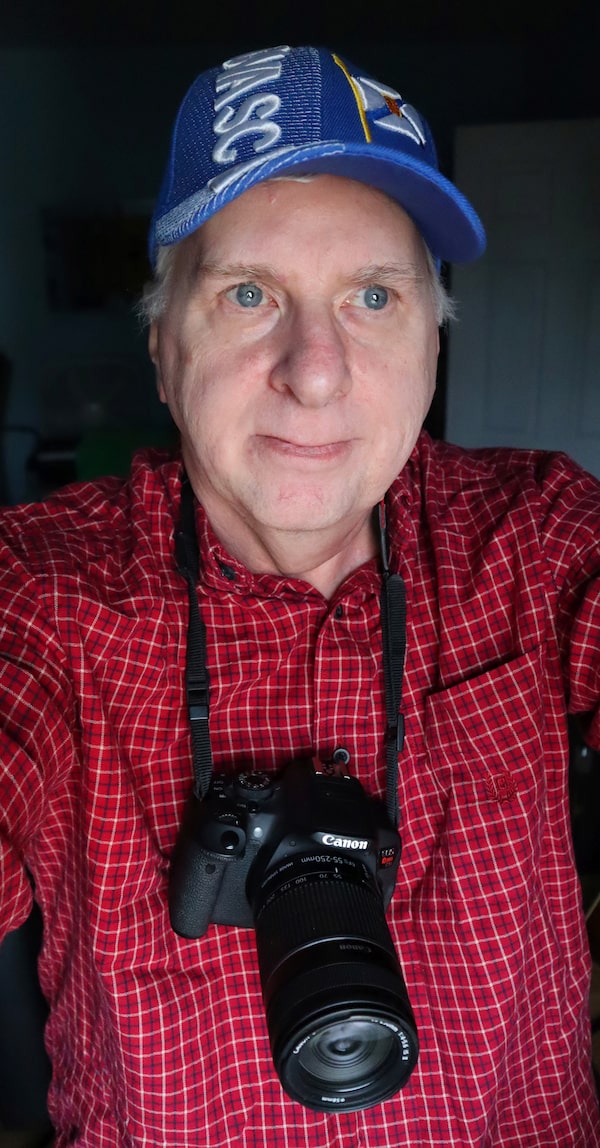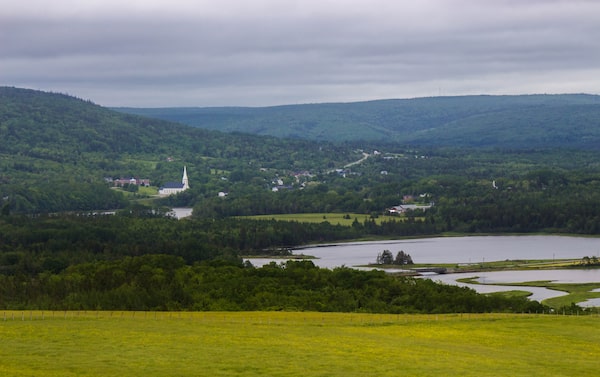
Francis MacDonald took this photo in Cape Breton soon after his cancer diagnosis. Later, his doctor likened the dark fog to the coming struggles, but said the sun would break the fog eventually. ‘His words really gave me hope and I kept going back to them,’ Mr. MacDonald says.Photography courtesy of Francis MacDonald
Soon after Francis MacDonald learned he had cancer, his friend offered to take him for a morning drive in Inverness off the western coast of Cape Breton. He was devastated by the diagnosis and needed a distraction.
They pulled over to drink their coffees and Mr. MacDonald, who never goes far without his camera, snapped a photo of the rugged shoreline blanketed in fog.
He later shared the photo with his doctor who told him it represented perfectly what he was about to go through. His doctor said it would be dark and dreary, but that the fog would lift, and the sun would shine again. Mr. MacDonald clung to those words for hope.

Mr. MacDonald with his camera.
The 65-year-old retired nurse had been diagnosed with squamous cell cancer after noticing some swelling in his neck. He had moments when he was fearful of dying and leaving his two grown sons and wife Rose behind and he leaned on his faith and on his camera.
“Between treatments, I’d be talking to someone and I’d hold up my camera and say ‘this is my therapy,’ ” he told The Globe in an interview, saying as a photographer he developed a deeper appreciation for the ocean and flowers because he trained his eye to see things he may not have before.
While Mr. MacDonald went outdoors and continued seeking creative ways to deal with stress intuitively, an effort is under way in Canada to encourage people dealing with a range of health issues to spend time in nature.
Melissa Lem, a family physician in British Columbia, is the director of PaRx, Canada’s national evidence-based nature prescription program. The program was first launched in British Columbia in 2020, has since spread to every province, and has been endorsed by the Canadian Medical Association. Through the program, health care professionals prescribe spending time in nature to their patients.
“We know that stress contributes to so many different diseases that anything that reduces your stress is going to improve your health,” she said, “And just giving your brain a break from everything that you have to worry about and so when you are less stressed, your immune system works better.”
Mr. MacDonald has enjoyed taking photos for years and has always found it to be therapeutic. But after his diagnosis, his passion helped him cope with the stress and pain that comes with having cancer. It pushed him to stay creative, and it forced him outdoors, which meant meeting people who offered encouragement. Now that he’s recovering, he wants others to know how much getting outside and staying creative can help.
“I was getting sicker and sicker and finding it more difficult. But I would still go out, make a little walk around the Sydney boardwalk, and take photographs. And of course, now when I go back and look at them, they remind me so much of what I was going through at that time,” he said.

‘This was the view from my hotel room in Sydney during treatment,’ Mr. MacDonald says. ‘I loved the view, especially at night.’
:format(jpeg)/cloudfront-us-east-1.images.arcpublishing.com/tgam/CEHCXSWPJRAVFABWZVQJSYPHY4.jpg)
:format(jpeg)/cloudfront-us-east-1.images.arcpublishing.com/tgam/MJY7SXBKNRCANHOQMCXN4P4O6E.jpg)
:format(jpeg)/cloudfront-us-east-1.images.arcpublishing.com/tgam/JAKOTVXICBE6FBWREWCPUALDRA.jpg)
:format(jpeg)/cloudfront-us-east-1.images.arcpublishing.com/tgam/WF5BSFASFFDURPFRD45UNGUB4I.jpg)
Mr. MacDonald spent most of last summer in Sydney while undergoing radiation treatment. Sometimes he would feel incredibly down, but as the evening came on and the sun set, he would walk the boardwalk with his camera, striking up a conversations with people he met.
Mr. MacDonald said he loves documenting life and photography because the minute you take a photo, it becomes a piece of history and seeing the result can be incredibly uplifting.
“Sometimes I would capture some beautiful photographs and then that would be something good to remember while going through it,” he added.
And going through it was hard, he said, saying he thought there was a good possibility he might die and so he prayed to God his life would be extended a bit longer.
His wife Rose also noticed how photography helped her husband. She said it helped his mental health in being able to pursue his passion even while going through the roughest part of his journey.
Mr. MacDonald said she would often say, “why don’t you go down to the ocean, down to Margaree, take some photos, just to take your mind off things.”

A canvas of this scene was donated for auction to the Cape Breton Hospital Foundation for this coming November.
Dr. Lem said spending time outdoors doesn’t necessarily come with the pressure of exercising, saying evidence shows that just being outdoors and sitting on a park bench can improve one’s health.
She prescribes nature regularly and said the standard recommendation is at least two hours in nature a week, for at least 20 minutes each time.
Mr. MacDonald said he has a leg up on some because living in Inverness means being surrounded by beautiful landscapes. He said the photos from when he was going through treatment may not have been his best work, but it meant focusing and that helped distract, even if it was only temporarily. He also wanted to document the experience. “I think I was just trying to take stock of things … I never dreamt that it would really help me.”
The photo that perhaps stands out the most is the one he shared with his doctor after he was diagnosed. He printed and framed the photo for his doctor, writing on the back the words he told him when he showed it to him the first time.
“I said, ‘You know what you told me really helped and I kept going back to that, that I’m gonna get through this and this is a photographic depiction of what was ahead and that’s just how it played out.’ ”
Behind the camera: More from The Globe and Mail
Ever wonder how a roll of film is developed? Learn the basics from the staff at Toronto's Downtown Camera.
The Globe and Mail
As millennials take up film, darkrooms see a bright future again